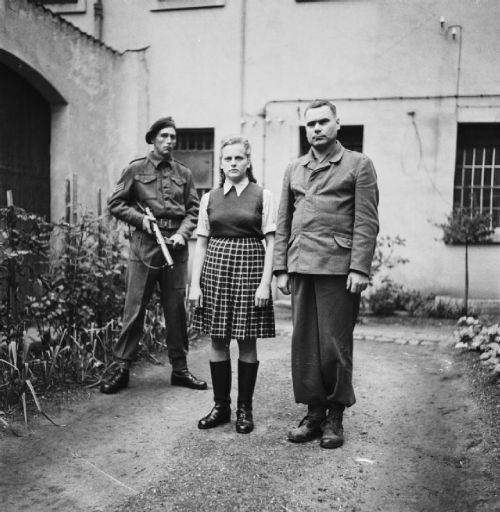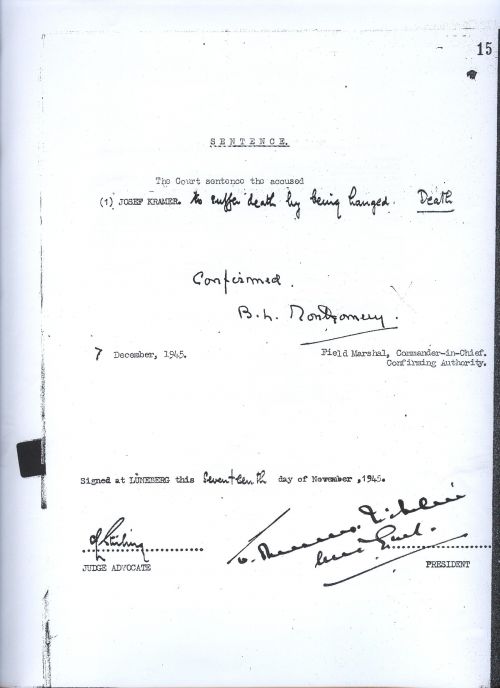Bergen-Belsen

Bergen - Belsen Camp (USHMM)
The detention camp (Aufenthaltslager) Bergen-Belsen, the official name for the camp, was established in the spring of 1943. Its purpose was to function as a transit camp for specific groups of Jewish prisoners who initially were excluded from the mass deportations to the extermination camps. They were to be held to be exchanged for Germans interned in Western countries.
The German authorities established in 1935, a camp with barracks for civilian workers not far from the new military training base at Belsen, near the town of Bergen, northern Germany. In June 1940, the German Army (Wehrmacht) took over control of these barracks and incarcerated 600 French and Belgian Prisoners of War (POW's). The camp was extended during May and June 1941 in anticipation of holding Soviet Union Prisoners of War and was re-named Stalag XI C (311) Bergen-Belsen.
The first transport of 2,000 Soviet POW's arrived in July 1941, and by the autumn of 1941, more than 21,000 Soviet POW's arrived at Bergen-Belsen, since very few huts had been constructed they were forced to sleep in the open, in earthwork dens, or from shelters made from branches. By the end of April 1942, some 14,000 of them had perished due to exposure, starvation and disease.
In April 1943, the SS- Business Administration Main Office (WVHA) took control of the southern part of the POW camp, in order to establish the detention camp, for exchange prisoners. It was true that the living conditions at first were better than those in other concentration camps. The first exchange transport of 2,300 Polish Jews arrived in Bergen -Belsen during July 1943. Those destined for 'exchange' were not to know the true conditions inside the National Socialist Concentration Camps. They were not to be in a position where they could report overseas on the conditions or provide evidence of those conditions by their own physical condition.
Nevertheless, the living conditions in Bergen-Belsen were somewhat worse than in the internment camps and the substation of the initial name of the camp, 'Civilian Internment Camp Bergen-Belsen', with the name 'Detention Camp,' on June 29, 1943, was justified on the grounds that a civilian internment camp would in accordance with the Geneva Convention be open for inspection by international commissions.
Even when the exchange prisoners in Bergen-Belsen were granted 'privileges' not available to prisoners in concentration camps - for example, they could take their luggage to Bergen-Belsen and wear their own civilian clothes in the camp, and the SS was strictly forbidden to mistreat the prisoners physically - the exchange prisoners were subject to arbitrary acts by the SS, such as hour-long roll calls and low rations.
The Reich Security Main Office (RSHA) issued guidelines on August 31, 1943, establishing criteria for the relocation of the Jewish prisoners in Bergen-Belsen as follows:
1. Jews who are either related to or have other relations with influential people in hostile overseas countries
2. Jews who are key to an exchange of Germans either interned overseas, or held prisoner overseas
3. Jews who, as hostages can be used to exert either political or economic pressure
4. Key Jewish personalities
These guidelines determined the social structure of the Detention Camp Bergen-Belsen, disregarding the so-called Prison Camp, a strictly separate area of the camp in which prisoners lived in typical concentration camp conditions. Bergen -Belsen initially held exclusively Jewish prisoners, and until the end of 1944, Jewish prisoners represented the majority of the total population in the camp. The exchange prisoners were not as a rule individuals, mostly whole families were deported to Bergen-Belsen with the result that right from the beginning there was a large number of children of all age groups. Men and women were held in separate barracks, but could meet each other during the day. Children lived with their mothers in the women's barracks, until they reached 15-years of age.
Unlike the other concentration camps, the inmates of Bergen-Belsen did not all live according to the same camp rules; living conditions varied according to the view the SS took of their legal status and their national origin. They lived in strictly separated parts of the camp. In the so-called 'Sternlager', because the prisoners had to wear the Jewish Star, lived the 'exchange Jews.' By July 1944, almost 4,400 Jews were held in this part of the camp, and this included Dutch Jews, who had arrived in Bergen-Belsen, via the Westerbork transit camp. Even elderly prisoners were forced to perform labour tasks in the 'Sternlager'.
Several hundred Jews from neutral countries lived in the so-called 'Neutralenlager,' mostly from Spain, Portugal, Argentina and Turkey. Unlike the other camps within Bergen-Belsen, the prisoners lived in relatively bearable conditions until March 1945, the prisoners in this came were not assigned to labour detachments.
In July 1943, as already mentioned 2,300 Polish Jews were incarcerated in the so-called 'Sonderlager,' - Special Camp. They held provisional papers issued by South American countries. They also were not assigned to labour detachments. They were strictly isolated from the other prisoners presumably because of their knowledge and experience of the massacres committed by the SS in Poland. The camp for the Jews of Hungary, the so-called 'Ungarnlager,' was established in July 1944, for 1,683 Hungarian Jews, the so-called Kastner Group. A small part of this group were released to Switzerland in August 1944, and a larger part in December 1944, not as part of an exchange of prisoners, but as the result of negotiations between the SS and a Zionist Aid Committee, represented by Reszo Kastner in Budapest. Heinrich Himmler -RFSS, had initiated the negotiations with the objective of making contact with the Western Allies via the release of the Jews with a view to finding a potential partner to negotiate a separate peace. The Hungarian Jewish prisoners were held in the Sternlager and were not forced to work. Shortly after the Kastner Group were released, a new group of Hungarian Jews was brought into that part of the camp, as the SS considered them as 'exchange Jews.'
The specific living conditions in the 'Detention Camp' in the beginning made it possible for an astonishing variety of cultural and religious life, which as a rule was only tolerated by the SS and could only take place in secret. By allowing the prisoners in the 'Detention Camp' to bring their luggage, they were given an important material foundation to maintain cultural and religious life inside Bergen-Belsen. They brought with them books, paper, pens and a variety of religious ritual objects. There are known to be 30 diaries written in secret by inmates that have survived. In addition more than 100 poems, mostly in Dutch and Polish, as well as dozens of drawings have also survived.
Very few prisoners in the Detention Camp were actually exchanged, though some 222 Jews were able to leave the camp at the end of June 1944, reaching Palestine in the months that followed. Another 136 reached Switzerland at the end of January 1945, as a result of exchange agreement for civilian personnel, between Germany and America. Also the Kastner Group transports already mentioned. For the rest, the overwhelming majority of the prisoners remained caught between the hope of freedom and the despair of the deteriorating living conditions in the camp, particularly from the middle of 1944. The hope of exchange meant that in the following months there was no open resistance, with no attempts to escape.
Beginning in the spring of 1944, the SS began to relocate other groups of prisoners, who had nothing to do with the planned exchange programme, to Bergen-Belsen. This turn of events began with a transport of sick prisoners, no longer capable of working from the Dora-Mittlebau Camp at the end of March 1944. This transport numbered exactly 1,000 prisoners who were sent to Bergen-Belsen supposedly to recuperate. There was in fact no medical care worthy of the name for these sick prisoners. In the months that followed the SS sent other transports with sick prisoners from other concentration camps to Bergen-Belsen, all of whom suffered a similar fate as those in the first transport from Dora- Mittlebau. In the summer of 1944, 200 prisoners in the prison were murdered by a prisoner functionary, whom the SS called the 'Senior Orderly.' with an injection of phenol.
In the autumn of 1944, the so-called 'Tent Camp' was established. It bordered on the 'Detention Camp' and initially it functioned as a transit camp for transports of female prisoners from Poland, who were sent to work in the armaments industry. In August and September 1944, three work detachments were established not far from Bergen-Belsen in Hambuehren, Unterluess, and Bomlitz. Female prisoners from Bergen-Belsen were made to work in these plants.
At the beginning of November 1944, the 'Tent Camp' in Bergen-Belsen held approximately 8,000 women, evacuated from Auschwitz -Birkenau. After the tents were destroyed in a storm, the prisoners were squeezed into the already overcrowded barracks. It was into this so-called small camp for females that a transport from Auschwitz-Birkenau brought Anne Frank and her elder sister Margot. Anne Frank became world-famous after the Second World War, with the publication of her diary. This diary was written in hiding from 1942, to 1944, until the family was arrested on August 4, 1944, after being betrayed. Anne and her sister Margot died in Bergen-Belsen during March 1945.
On December 1, 1944, SS- Hauptsturmführer Josef Kramer, who had been the commandant of Birkenau Camp, in the Auschwitz Concentration Camp complex took over the command of the camp from SS- Obersturmbannnführer Adolf Haas, who was killed in action on March 31,1945.
In the face of the advance by the Soviet forces, concentration camps close to the front began to be evacuated from the autumn of 1944, in a westerly direction and Bergen-Belsen became more and more used to hold these evacuation transports. To accommodate these transports, the camp was expanded. Thus in January 1945, the Prisoner of War hospital in the northern half of the camp complex was dissolved and became part of the Bergen-Belsen Concentration Camp. This became the site of the 'Grosses Frauenlager' (Large Women's Camp).
As a result of this change of role for Bergen-Belsen and the rapid increase in prisoner influx, the camp changed from a 'Detention Camp' holding hostages for exchange, into a de facto death camp. The numerous evacuation transports that were sent to Bergen-Belsen from the end of 1944, led to a catastrophic overcrowding in the camp. At the beginning of December 1944, there were around 15,000 prisoners in the camp, this increased to around 22,000 by February 1, 1945, and by March 1, 1945, this had risen to 41,250.
In the hastily constructed, completely overcrowded, and mostly unheated barracks, there was often no furniture of any description so the countless prisoners had to lie on the ground. Hunger and illness, which the SS ignored, determined the life of the prisoners in those areas of the camp, where the living conditions had once been bearable. Vermin and diseases, such as typhus, dysentery, and tuberculosis caused a great number of deaths in the confined spaces where there was a complete lack of hygiene and medical care. In March 1945, alone, more than 18,000 prisoners died in Bergen-Belsen. The hunger reached an unimaginable dimension with the result that in the last weeks before the camp was liberated, there were numerous documented cases of cannibalism.
As the British troops approached Bergen-Belsen, the SS attempted to remove the thousands of corpses on the camp grounds. Between April 11, 1945, and April 14, 1945, those prisoners still capable of walking were forced to drag corpses to mass graves. Shortly before, the SS had transported away the 'exchange Jews.' Three trains departed with 8,000 Jews between April 6, 1945, and April 11, 1945. For hundreds this meant death; One of the trains reached Theresienstadt, in Bohemia. The other two trains roamed around for days, before being liberated by US forces near Magdeburg, and by Soviet forces near Trobitz.
When British forces liberated the Bergen-Belsen Concentration Camp on April 15, 1945, as part of a local cease-fire -both sides wanted to prevent the outbreak of epidemics - there were 55,000 prisoners in the camp. In the last days before liberation, several thousand male prisoners were held in the Lager II, located in part of the barracks on the nearby troop training ground at Bergen-Hohne. On the camp grounds and in the barracks in Bergen-Belsen, the British forces found thousands of un-buried corpses. Despite the efforts of the British -within a few weeks 14,000 emergency hospital beds were erected in the barracks complex on the troop training ground - help came too late for many of the liberated prisoners: in the first 12 weeks after the liberation more than 13,000 prisoners died, as a result of their incarceration in Bergen-Belsen. The total number of victims in Bergen-Belsen Concentration Camp is estimated at 50,000.
That the SS were able to destroy almost all of the files of the Bergen-Belsen Concentration Camp before the camp was liberated, this made it difficult to determine statistical and bio-graphical information not only on the prisoners, but also on the SS personnel who staffed the garrison. As in other camps, there was constant fluctuation of SS personnel. It is known that there were 435 men and 45 women SS personnel. Most of them were transferred in two waves: one from the Wewelsburg - Niederhagen Concentration Camp, along with the first commandant Adolf Haas, when the camp was first established, and the second wave when the transports arrived from Auschwitz-Birkenau, along with SS female guards who escorted these prisoners.
Only approximately 50 SS men and 20-30 SS women remained in the camp, where they were arrested by the British forces, these included commandant Josef Kramer and female SS -woman Irma Griese, who had both served at Auschwitz -Birkenau Concentration Camp in Poland, as well as others such as Dr. Fritz Klein, and Fritz Hossler.

Irma Griese and Josef Kramer - Arrested by British Forces in Bergen -Belsen
In the autumn of 1945, 21 of these SS men and 16 of the SS women, as well as 11 prisoner-functionaries were tried by a British Military Court in Luneburg. As previously mentioned as some of the accused had served in Auschwitz Concentration Camp, they were tried in Luneburg for crimes committed there. The Luneburg 'Belsen Trial' was not only one of the earliest war crimes trials, but was in fact the first 'Auschwitz Trial.' The court delivered its verdicts on November 17, 1945; 11 of the accused were sentenced to death, 19 received prison terms, and 14 were acquitted. The death sentences were carried out at the prison in Hameln, during the middle of December 1945.

Josef Kramer's Death Sentence Signed by Field Marshal B. Montgomery - November 1945
In May 1946, a second 'Belsen Trial' took place in Celle; 10 defendants were tried, 4 more death sentences were issued, as well as terms of imprisonment for the others who stood trial. The four found guilty were hanged in Hameln prison during October 1946.
Sources
Encyclopaedia of Camps and Ghettos 1933- 1945, USHMM, Indiana University Press Bloomington and Indianapolis 2012
Bergen-Belsen stiftung.ng.de
French L. Maclean, The Camp Men, Schiffer Publishing Ltd 1991
G. Reitlinger, The Final Solution, Vallentine Mitchell, London 1953
Wiener Library, London, UK
Photograph: USHMM & Private Archives
National Archives Kew
Dedicated to John Dalton and John Walsh - 2 British Army Soldiers, serving with the Scots Guards, who took part in the liberation of Bergen-Belsen Concentration Camp in 1945
© Holocaust Historical Society, March 27, 2021

